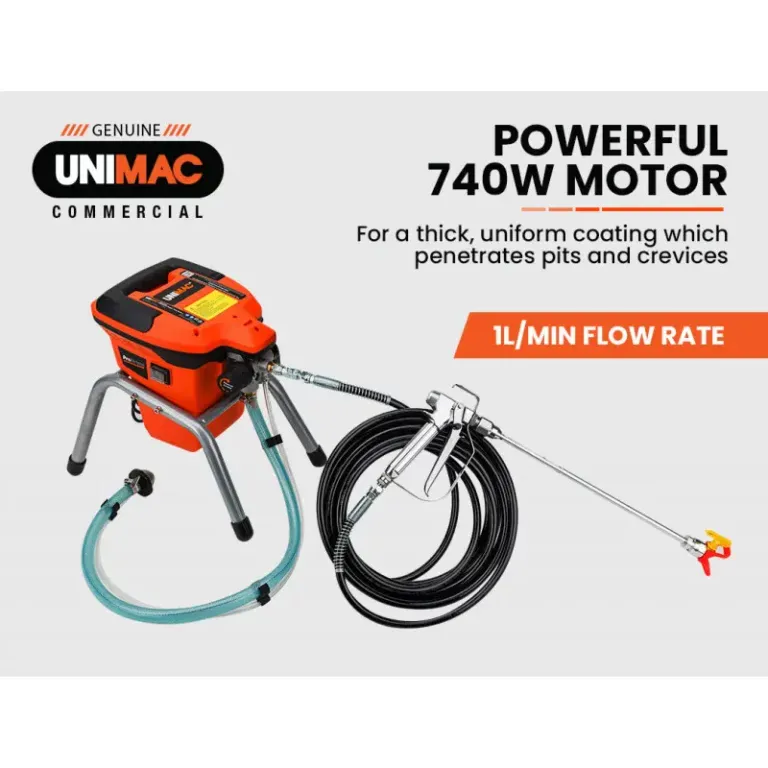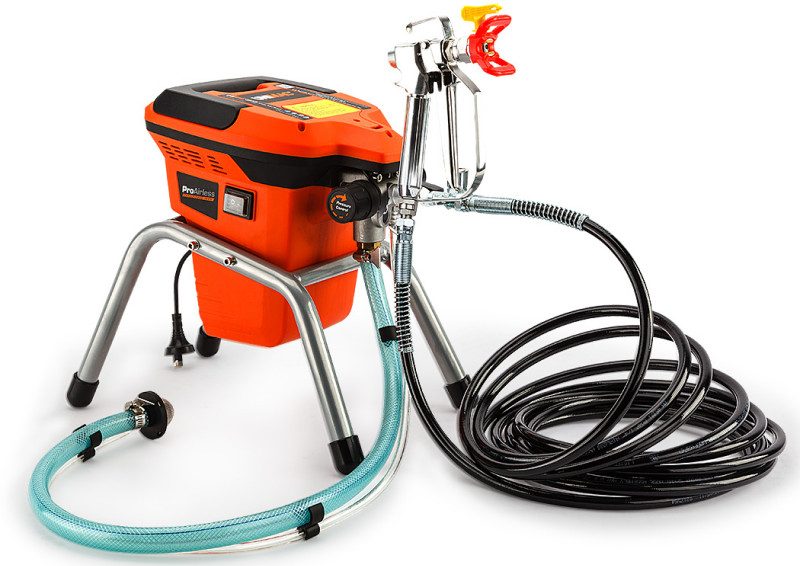UNIMAC 740W Electric Airless Paint Station for Emergency Recovery: A Full PPRR Guide
Excerpt: The UNIMAC 740W airless paint station can speed up safe building recovery after fires, floods, and storms. This guide shows crews and households how to plan, operate, and maintain the sprayer using Prevention, Preparedness, Response, and Recovery—plus real‑world scenarios, checklists, and coordination tips.
Last updated: 13 August 2025 (AEST)
Prevention — Controlling Risks Before You Spray
A well‑managed worksite prevents injuries, property damage, and costly delays. Using the UNIMAC 740W airless paint station in emergency recovery (e.g., sealing smoke‑stained walls, restoring community facilities, or re‑marking safety signage) demands a focus on risk controls, duty of care, and practical planning.
Apply a layered approach to risk management: eliminate hazards where possible; substitute safer coatings; engineer ventilation and cord management; use administrative controls like permits and spotters; and finish with appropriate PPE. This hierarchy reduces the chance of solvent fires, overspray contamination, electrocution, trips, and skin injection injuries.
- Flammability & ignition sources: Keep heat, sparks, cigarettes, and hot tools away from flammable coatings. If a generator powers the unit, position it outdoors, down‑wind, and away from vapours.
- Electrical safety: Use an RCD‑protected circuit. Inspect cords, avoid daisy‑chaining powerboards, and route leads overhead or along edges to prevent trips.
- Ventilation: Ensure cross‑flow ventilation for solvent‑based coatings; consider mechanical extraction. Poor ventilation raises VOC exposure and ignition risk.
- Compatibility: Only use coatings compatible with airless sprayers and the supplied hose/filters; confirm viscosity and tip size to avoid over‑pressure.
- Surface prep: Remove soot, mould, and loose debris. Sealing char/odour often requires stain‑blocking primers; confirm product data before application.
- Neighbouring assets: Mask fire‑detection heads where the procedure allows, and protect appliances, first‑aid stations, and egress signage from overspray.
- Respiratory and dermal exposure: Match PPE to the coating’s Safety Data Sheet. Consider half‑face or full‑face respirators (with appropriate filters), eye protection, and chemical‑resistant gloves.
Duty of care: supervisors must ensure workers are trained in high‑pressure safety, lock‑out/tag‑out practice, first‑aid response for injection injuries, and spill containment. Keep the manual and SDS on site.
Preparedness — People, Planning, and Kits
Preparedness ensures the UNIMAC 740W sprayer is mission‑ready when the job is time‑critical, such as restoring safe corridor markings at an evacuation centre or sealing water‑damaged interiors to prevent mould. Build capability with training, rehearsals, and a ready‑to‑deploy kit.
- Assemble, prime, and depressurise safely.
- Identify tip sizes, filters, and viscosity limits.
- Demonstrate lock‑out/tag‑out and pressure relief.
- Perform a clean changeover between coatings.
- UNIMAC 740W unit, hose, and gun with guard.
- Assorted spray tips; spare seals and filters.
- Strainers, mixing sticks, and viscosity cup.
- Tarps, masking film, and painter’s tape.
- Approved cleaning solvents or water (as specified).
- Safety glasses or face shield, hearing protection.
- Respirator with correct filters for the coating.
- Chemical‑resistant gloves, coveralls, and boots.
- First‑aid/eyewash, spill kit, fire extinguisher.
- Check RCD and power leads; inspect hose and gun guard.
- Confirm coating, tip size, and filter match the task.
- Set ventilation and exclusion zones; brief the team.
- Stage PPE, spill kit, and extinguisher; verify eyewash.
- Review pressure‑relief steps; designate a spotter.
Response — Safe First Actions Under Pressure
When facilities must reopen quickly, speed matters—but never at the expense of safety. A disciplined start‑up sequence prevents incidents and improves finish quality, especially when teams work alongside electricians, cleaners, and building inspectors.
- Brief & pre‑start: Confirm scope, coating type, ventilation, and exclusion zones. Assign a spotter.
- Inspect & set up: Check hose integrity, tip guard in place, and fittings tight. Secure cords to walls or overhead lines.
- Prime & test: Prime into a waste container. Test pattern on a card; adjust pressure and distance (typically 250–300mm) for even coverage.
- Apply: Maintain steady pace and overlap by 50%. Control trigger at each pass end to avoid thick edges and runs.
- Monitor exposure: Rotate operators, track ventilation, and watch for fatigue. Switch filters if pressure spikes or pattern tails.
- Pressure‑relief: On any pause, follow the full pressure‑relief procedure before cleaning, unclogging, or changing tips.
- Lookouts: Spotter monitors overspray drift, trip hazards, and ignition sources.
- Comms: Radios or hands‑free with plain language; confirm pause/stop calls.
- Escape routes: Keep exits clear of masking and equipment.
- Safety zones: Exclusion areas for public and non‑essential workers.
Recovery — From First Coats to Community Re‑opening
Sprayers are force multipliers in recovery. After a fire, flood, or storm, the UNIMAC 740W can help seal smoke odours, restore hygiene surfaces, and refresh wayfinding. Plan for phased re‑occupancy: critical zones first (toilets, first‑aid rooms, kitchens), then public spaces, then exterior works.
- Health considerations: Prioritise low‑odour, low‑VOC products where possible. Maintain ventilation during curing.
- Documentation: Photograph before/after, record batch numbers, and store SDS for insurance and quality assurance.
- Quality checks: Inspect coverage, adhesion, and finish under consistent light; touch‑up only after cure time.
- Handover: Provide cure time guidance and any re‑entry limits to facility managers.
How It Works — The Operational Science
An airless sprayer pressurises coating and forces it through a small orifice tip, forming a fan pattern without compressed air. The UNIMAC 740W unit’s motor drives a pump that creates the pressure needed for atomisation. Correct tip sizing, filtration, and pressure produce consistent film thickness and rapid coverage.
Tip size & pattern: Tips are coded for orifice and fan width. Bigger tips increase flow but can overload surfaces; smaller tips may cause tails (stripes) if pressure is too low. Start with manufacturer recommendations for each coating and surface.
Filters & strainers: Fine filters reduce tip clogs but can restrict flow. If you see pulsation or pattern collapse, check the filter for loading and the coating for viscosity changes due to temperature.
Distance & travel speed: Keep a steady 250–300mm between the tip and surface, perpendicular to the wall. Overlap passes by 50% to avoid striping; release the trigger at the end of each pass.

Need pro‑grade accessories and PPE to support safe spraying? Explore deals from a trusted Australian retailer.
Roles & Coordination — Who Does What
In multi‑agency recovery, spraying often runs in parallel with electrical repairs, mould remediation, and demolition. Use a simple ICS‑style structure to maintain clarity: an overall Coordinator (or Incident Controller), an Operations Lead for the sprayer crew, a Safety Officer, and a Logistics Lead for materials, waste, and access.
- Controller: Confirms scope, approvals, and schedule with the facility owner; resolves conflicts between trades.
- Operations Lead: Plans sequence, allocates zones, signs off on surface prep and masking.
- Safety Officer: Checks ventilation, PPE compliance, exclusion zones, and ignition controls; monitors fatigue.
- Logistics: Manages coating deliveries, waste handling, and cleaning solvents; secures electrical supply and RCDs.
- Public liaison: Provides re‑entry times and odour expectations to staff and residents.
Stagger tasks to minimise idle time: while one operator sprays, others mask the next room, mix coating, and manage cord/hose routes. Run short ‘quality gates’ at each handover rather than one big inspection at the end.
Equipment & Tools — Matching the Job
The UNIMAC 740W airless sprayer is portable and suited to interior walls, ceilings, and large flat surfaces. For small trims and tight spaces, switch to smaller tips or use a brush/roller cut‑in before spraying broad areas.
- Motor and pump assembly (740W)
- High‑pressure hose (inspect before each use)
- Spray gun with trigger safety and tip guard
- Tips (various fan widths) and in‑line filters
- Masking film, drop sheets, and edge tools
- Viscosity cup and measuring jug
- Extension pole for ceilings
- Bucket screens/strainers
- Manufacturer‑approved lubricants
- Spare packings, O‑rings, and seals
- Cleaning solvents and labelled waste containers
- Tool kit for tip changes and hose fittings
Perform a weekly deeper clean: flush until clear, remove and inspect filters, check tip wear, and examine hose for abrasion. Tag‑out and replace if any steel braid is exposed.
Field Scenarios — Lessons from Real Jobs
A small kitchen fire left odour and soot. After HEPA vacuuming and detergent wash, crews primed ceilings and walls with stain‑blocking primer using the UNIMAC 740W. Ventilation and staged re‑entry reduced complaints. The hall reopened for relief services in 24 hours.
Drywall was replaced up to the flood line. Sprayer cut the painting time in half, enabling faster clinical cleaning and equipment return. Strict cord management and exclusion zones prevented trips in crowded corridors.
An evacuation centre needed clear arrows and room labels. Crews masked and sprayed colour‑coded walls and frames, improving navigation and reducing congestion. Public liaison posted re‑entry times to avoid wet‑paint incidents.
Checklists — Household, Business, Responders
- Confirm coating type; prefer low‑VOC indoors.
- Mask smoke alarms if permitted; re‑enable after.
- Keep kids/pets out; ventilate during and after.
- Store solvents away from heat; secure lids.
- Know pressure‑relief before any tip change.
- Permit to work; SDS on hand; signage in place.
- Coordinate with HVAC to avoid recirculating vapours.
- Set exclusion lanes; protect critical equipment.
- Document batch numbers and cure times.
- Waste manifest for solvent disposal.
- Toolbox brief: ignition control, PPE, evacuation routes.
- Electrical check: RCD, leads, and load limits.
- Spotter assigned; radio checks confirmed.
- Quality gate after first coat in each zone.
- Tag‑out defective tips, hoses, or guards immediately.
Accessibility & Inclusion — Making Works Safe for Everyone
Emergency recovery serves whole communities. Plan works so children, older adults, people with disabilities, and those with respiratory conditions stay safe and informed.
- Use plain‑language signs and include symbols. Provide information in large type and audio if possible.
- Schedule high‑odour work when vulnerable users are off‑site.
- Maintain clear, step‑free detours around wet‑paint zones.
- Offer mask alternatives and quiet rest areas for those sensitive to noise and smell.
FAQs — UNIMAC 740W and Emergency Recovery
What coatings are suitable for the UNIMAC 740W?
How do we prevent injection injuries?
Is ventilation required with low‑VOC paints?
Can the sprayer run from a generator?
What’s the difference between tip sizes?
How do we manage odour complaints?
Do we need a permit to work?
What about mould remediation?
Links & Hotlines — Australia
- Triple Zero (000): Police, Fire, Ambulance
- SES 132 500: Storm & flood help
- Bureau of Meteorology — warnings and weather
- Healthdirect — medical advice (non‑emergency)
- Safe Work Australia — WHS guidance
- CFA Victoria • NSW RFS • QFES • DFES WA
- SafeWork NSW • WorkSafe Victoria
- Poisons Information (13 11 26)
Emergency Contacts Quick List
For local council recovery centres, check your council website or social media.
Not emergency advice: This article supports education and planning. Always follow manufacturer instructions, site rules, and official guidance. Training helps — join your local brigade/unit.
Credits & Review Notes
Content prepared for Australian households, businesses, and responders, aligning with basic WHS principles and safe‑use practices for airless sprayers. Reviewed for readability and practical field application. Always consult the UNIMAC manual and coating SDS before use.
Focus Keyword: UNIMAC 740W



